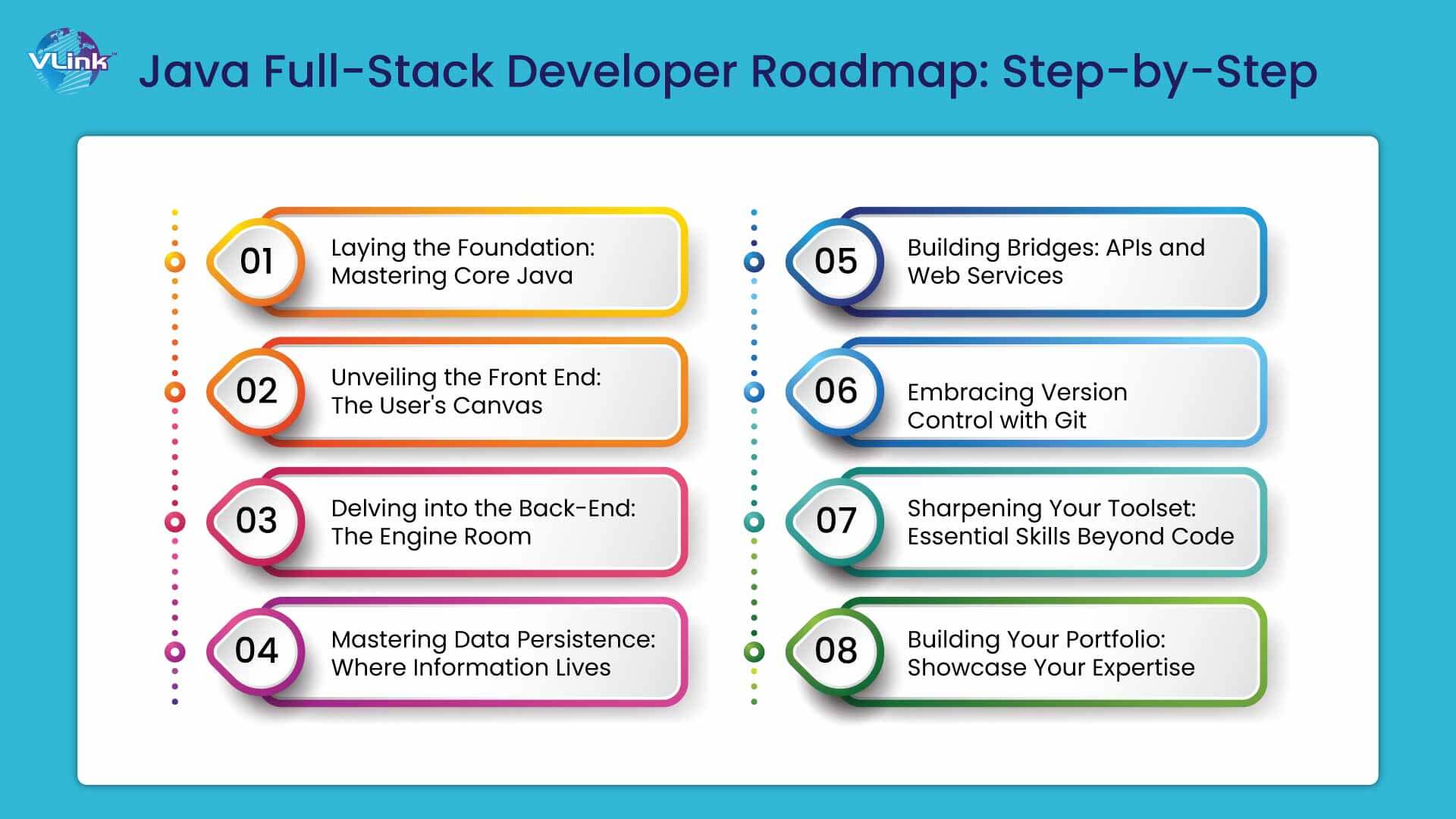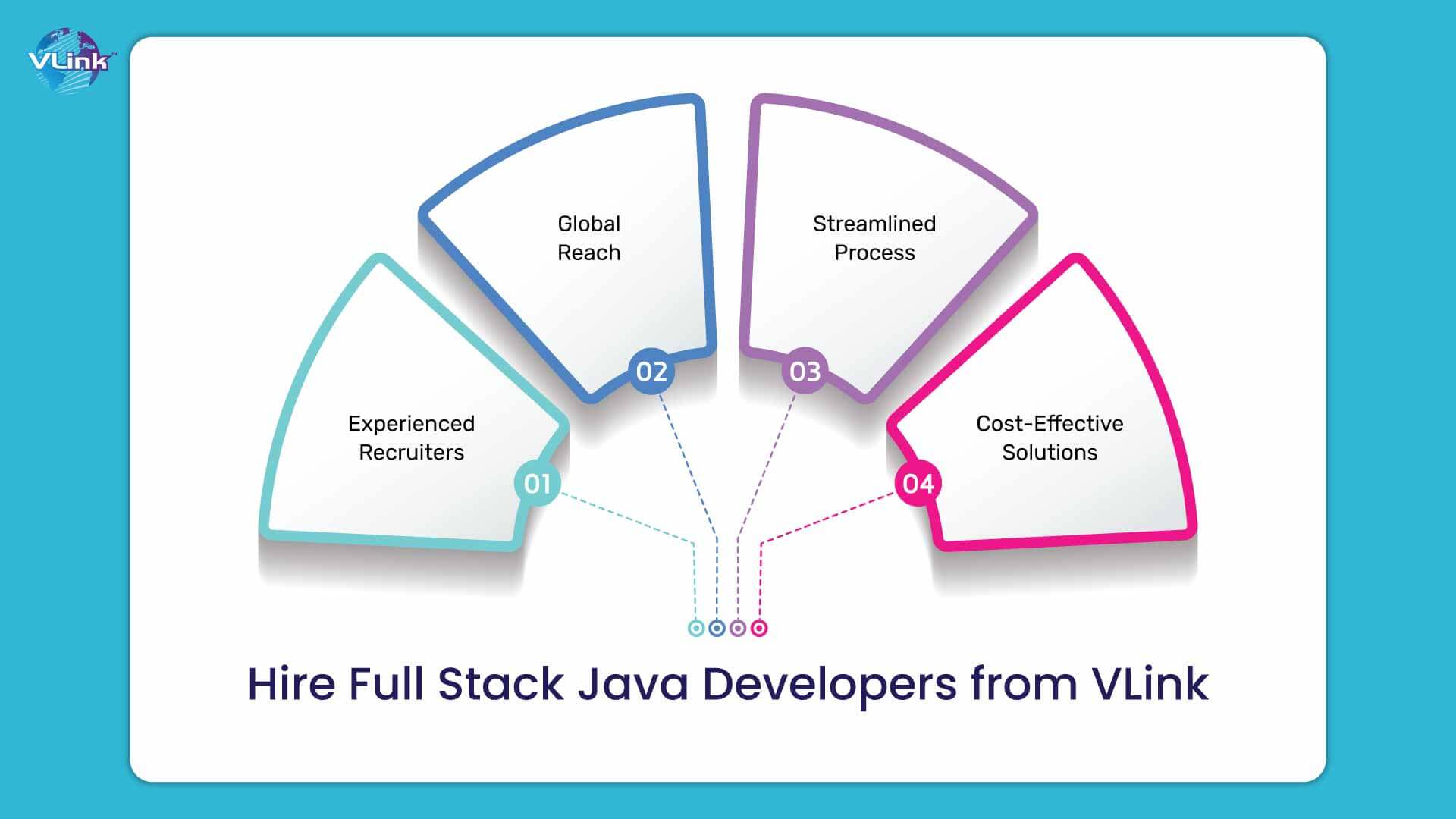Full Stack Java developers are in high demand due to several key reasons:
The versatility of Java for both frontend and backend development
- Cross-platform compatibility
- Scalability
- Strong adoption in enterprise applications
Their expertise in building efficient, maintainable systems across various domains drives their demand in the tech industry.
If you are aspiring to become a Full Stack Java developer, this comprehensive guide will serve as your roadmap to success. We'll provide you with the knowledge and resources needed to embark on this rewarding career journey.
Who is a Full Stack Java Developer?
Imagine a web application as a magnificent orchestra. The user interface, the elements you interact with on the screen, is like a captivating melody. But behind the scenes, the back-end acts as the intricate score, ensuring everything runs smoothly. Hiring a full-stack developer with the expertise to be both the conductor and the composer, wielding the power of Java to create exceptional web experiences.

Here's a breakdown of their key skills:
- Front-End Mastery: They're fluent in the languages that bring websites to life – HTML for structure, CSS for styling, and JavaScript for interactivity. They might also leverage popular frameworks like React, Angular, or Vue.js to streamline development.
- Back-End Expertise: They can write robust server-side code using Java frameworks like Spring, Spring Boot, or JEE. This code handles user requests, processes data, and interacts with databases.
- API Fluency: They understand how to build APIs (Application Programming Interfaces) that act as bridges, enabling seamless communication between the front-end and back-end components.
- Database Savvy: They possess the knowledge to design and manage databases like MySQL, PostgreSQL, or Oracle, ensuring efficient data storage and retrieval for the application.
- Testing and Debugging: They are meticulous troubleshooters who implement various testing strategies to identify and fix any bugs or glitches that may arise.
- DevOps Awareness: They understand the principles of continuous integration and deployment (CI/CD), allowing for streamlined development workflows.
Java Full-Stack Developer Roadmap: Step-by-Step

Conquering the realm of Java full-stack development requires a strategic approach. Here's a step-by-step roadmap to equip you with the necessary skills:
1. Laying the Foundation: Mastering Core Java
- Core Java Concepts: Your journey begins with a solid foundation in core Java concepts. Your essential building blocks are object-oriented programming (OOP) principles, data types, operators, control flow statements, inheritance, polymorphism, and exception handling. Numerous online resources, tutorials, and books can guide you.
- Java SE (Standard Edition): Familiarize yourself with the Java SE platform, which provides core functionalities like APIs for file I/O, networking, and collections. This will empower you to write well-structured and efficient Java code.
2. Unveiling the Front-end: The User's Canvas
- HTML and CSS: Grasp the fundamentals of HTML for structuring web pages and CSS for transforming them into visually appealing interfaces. Many interactive online tutorials and playgrounds can help you experiment and visualize the impact of CSS properties.
- JavaScript: Delve deeper into JavaScript, which injects life into web pages. Learn about variables, functions, DOM manipulation, event handling, and asynchronous programming. Consider online courses or interactive coding platforms like Codecademy or FreeCodeCamp. These platforms offer a structured learning environment and keep you engaged.
- Front-End Frameworks: Once comfortable with the basics, explore popular front-end frameworks like React, Angular, or Vue.js. These frameworks offer pre-built components, streamlined development processes, and a vibrant community for support. Learning a framework can significantly improve your development speed and efficiency.
3. Delving into the Back-end: The Engine Room
- Java Frameworks: Spring and Spring Boot are widely used frameworks for building enterprise-grade Java applications. Spring offers a comprehensive set of abstractions to simplify complex functionalities, while Spring Boot focuses on rapid application development by reducing configuration overhead. Choose the framework that aligns best with your project requirements.
- JEE (Java Platform, Enterprise Edition): If you aim for large-scale, distributed applications, consider exploring JEE. It's a collection of Java specifications offering web services, security, and transaction features, providing a robust foundation for building complex enterprise applications.
4. Mastering Data Persistence: Where Information Lives
- SQL Fundamentals: Learn the fundamentals of SQL (Structured Query Language) to interact with relational databases like MySQL, PostgreSQL, or Oracle. Online tutorials and practice platforms can help you write queries and manage data effectively. Understanding SQL is crucial for storing and retrieving data efficiently within your applications.
- Object-Relational Mapping (ORM): Explore ORMs like Hibernate or JPA, which simplify the process of mapping Java objects to database tables. This reduces boilerplate code (repetitive code) and fosters cleaner development practices, allowing you to focus on your application's core logic.
5. Building Bridges: APIs and Web Services
- RESTful APIs: Understand the principles of REST (Representational State Transfer) architecture. RESTful APIs are designed to be lightweight and interoperable, enabling seamless communication between your application's front-end and back-end components.
- RESTful Web Services: Learn how to build RESTful web services using frameworks like Jersey or Spring MVC. These frameworks provide tools and functionalities to expose functionalities within your back-end to other applications or front-end components through well-defined APIs.
6. Embracing Version Control with Git
Master Git, a popular VCS, is used for version control, tracking code changes, collaborating with other developers, and deploying code to production environments. Platforms like GitHub offer a user-friendly interface for learning and practicing Git commands. Version control ensures you can revert to previous versions of your code if needed and facilitates collaboration by allowing multiple developers to work on the same project simultaneously.
7. Sharpening Your Toolset: Essential Skills Beyond Code
While technical skills are crucial, becoming a successful Java full-stack developer requires honing additional tools in your belt:
- Integrated Development Environments (IDEs): IDEs like IntelliJ IDEA or Eclipse provide a robust development environment with features like code completion, syntax highlighting, debugging tools, and project management functionalities. These features can significantly enhance your development experience and efficiency.
- Problem-Solving Skills: Analyzing problems, breaking them down into smaller steps, and finding creative solutions is an invaluable asset in any development role. Hone your problem-solving skills by actively tackling coding challenges and participating in online communities like Stack Overflow.
- Communication Skills: Effective communication with team members, designers, and clients is essential. You need to understand project requirements, collaborate effectively, and troubleshoot any issues that may arise. Communication skills ensure everyone is on the same page and projects run smoothly.
8. Building Your Portfolio: Showcase Your Expertise
The best way to demonstrate your skills and capabilities as a Java full-stack developer is by building a strong portfolio:
- Hands-on Projects: Build small personal projects to experiment with different technologies and frameworks. This deepens your understanding and lets you showcase your versatility in your portfolio. Consider building a simple to-do list app, a blog with user authentication, or a portfolio website.
- Open-Source Contribution: Contributing to open-source projects allows you to collaborate with other developers, learn industry best practices, and build a strong portfolio demonstrating your real-world coding experience. Look for projects on GitHub that align with your interests and skill level. Even small contributions can be valuable.
- Focus on Quality: When building your portfolio, prioritize the quality of your projects over quantity. Choose projects that showcase your full-stack abilities in building the front-end Ucreatingend logic and database interaction. Ensure your code is well-documented, clean, and follows coding best practices.
- Remember: Consistent practice is key! Throughout your learning journey, build personal projects. This allows you to experiment with different technologies, showcase your skills in a portfolio, and solidify your understanding of the concepts you learn.
Career Opportunities for Java Full Stack Developer
The demand for Java full-stack developers is high across a wide range of industries, including:
Building secure and scalable applications for online banking, investment platforms, and risk management systems. Java's security features and robust libraries make it a preferred choice for financial institutions.
Developing engaging and user-friendly online stores, customer management systems, and payment processing solutions. Java's ability to handle high traffic and complex transactions makes it ideal for e-commerce platforms.
Creating innovative applications for patient records management, appointment scheduling, and telemedicine solutions. As healthcare embraces digital solutions, Java's scalability and reliability are valuable assets.
Building educational platforms, learning management systems, and online collaboration tools. Java's ability to handle large datasets and its widespread adoption in educational institutions make it suitable for EdTech solutions.
Developing streaming platforms, social media applications, and content management systems. Java's performance and ability to handle large user bases make it a popular choice for the entertainment industry.
Future of Java Full Stack Developers
Here's why Java full-stack developers can look forward to a promising future:
- Mature and Stable Language:
Java has a long history of reliability and security, making it ideal for building complex and mission-critical applications. Companies heavily invested in Java applications will unlikely switch to a new language anytime soon, ensuring continued demand for Java developers.
- Large and Active Developer Community:
Java boasts a vast and active developer community, providing abundant resources, libraries, and frameworks for developers to leverage. This supportive community ensures ongoing learning opportunities and access to solutions for any challenges you might encounter.
- Continuous Evolution:
The Java ecosystem constantly evolves, with new features and frameworks introduced to keep pace with changing technologies. As a Java full-stack developer, you'll always have opportunities to expand your skillset and stay current with the latest advancements.
So, staying updated with emerging trends like cloud computing, microservices architectures, and containerization technologies like Docker will be crucial for Java full-stack developers to remain competitive in the long run. Ready to Take the First Step?
This roadmap has equipped you with the knowledge and resources to embark on your journey to becoming a full-stack Java developer. Remember, success doesn't happen overnight, but you can achieve your goals with dedication, hard work, and a love for learning.
Here are some additional resources to get you started:
- Online Courses: Platforms like Coursera, Udemy, or Udacity offer a variety of Java full-stack development courses.
- Books: Classic texts like "Head First Java" or "Effective Java" offer in-depth explanations of core Java concepts.
- Tutorials: Websites like W3Schools or Tutorialspoint provide free tutorials and coding exercises for practicing various technologies.
- Online Communities: Join communities like Stack Overflow or the r/java subreddit for discussions and troubleshooting help, and stay updated with industry trends.
So, take the first step today and begin your exciting journey as a Java full-stack developer!
Hire Full Stack Java Developers from VLink

While this guide focuses on empowering you to become a full-stack Java developer, we understand that some companies might require immediate talent acquisition. If you're a recruiter or business owner seeking to hire Java developers for success, VLink can be your trusted partner.
VLink team connects businesses with top-notch IT talent, including Java developers. With our vast network and rigorous screening process, we can help you find the perfect candidate to meet your specific needs.
- Experienced Recruiters: Our dedicated team of professional recruiters deeply understands the Java development landscape and can identify top talent that aligns with your specific project requirements.
- Global Reach: VLink has a vast network of Java developers worldwide, ensuring you have access to a diverse pool of qualified candidates.
- Streamlined Process: We handle the entire recruitment process, from initial screening to interview scheduling, saving you valuable time and resources.
- Cost-Effective Solutions: VLink offers competitive rates and flexible engagement models to suit your budget and project needs.
Contact us today if you're looking for top-tier Java full-stack developers to join your team. We'll work closely with you to understand your requirements and find the perfect candidates to help you achieve your business goals.
Conclusion
Becoming a Java full-stack developer is a rewarding career path that opens doors to many opportunities. By following this comprehensive roadmap, equipping yourself with the necessary tools and skills, and continuously honing your knowledge, you can position yourself for success in this dynamic field.
Remember, the most successful developers are passionate about their craft, constantly striving to learn and improve and finding joy in problem-solving. So, take the first step today, embark on your journey to becoming a masterful Java full-stack developer, and enjoy the exciting possibilities that await you!
Frequently Asked Questions
Yes, you can! While it will require dedication and hard work, a background in coding isn't mandatory. The key is to develop a strong foundation in programming concepts. Start with a beginner-friendly language like Python or JavaScript to grasp core principles like variables, data types, and control flow. Once comfortable, transition to Java, leveraging online resources and courses designed for beginners. The journey might take longer, but you can achieve your goal with perseverance and a passion for learning.
Beyond mastering Java itself, several tools are essential for your developer toolkit:
- Integrated Development Environment (IDE): IDEs like IntelliJ IDEA or Eclipse provide a comprehensive development environment with features like code completion, debugging tools, and project management functionalities. These features streamline your development process and enhance efficiency.
- Version Control System (VCS): Git, a popular VCS, allows you to track code changes, collaborate with other developers, and revert to previous versions if needed. Platforms like GitHub offer a user-friendly interface for learning and practicing Git commands. Version control ensures your code is organized, facilitates collaboration, and safeguards your work.
- Database Management Tools: MySQL Workbench or pgAdmin are some options for interacting with relational databases like MySQL or PostgreSQL. These tools allow you to write queries, visualize data structures, and manage databases effectively. Understanding how to interact with databases is fundamental for storing and retrieving data within your applications.
Congratulations on building a solid foundation in Java! It's time to expand your skill set to encompass front-end and back-end development. Here's how:
- Front-End Technologies: Learn HTML, CSS, and JavaScript – the building blocks of user interfaces. Numerous online tutorials and interactive playgrounds can help you grasp these languages. Once comfortable, explore popular front-end frameworks like React, Angular, or Vue.js to streamline development and create dynamic user experiences.
- Back-End Frameworks: Spring, Spring Boot, or JEE are widely used frameworks for building enterprise-grade Java applications. Explore tutorials and documentation to understand their functionalities. Choose the framework that best suits your project needs and interests.
- APIs and Web Services: Learn how to build APIs (Application Programming Interfaces) that bridge front-end and back-end components. Frameworks like Jersey or Spring MVC can equip you with the tools to create well-defined APIs for seamless communication within your applications.
Here's a recommended approach to navigate the Java ecosystem effectively:
- Start with the Basics: Focus on core Java concepts like object-oriented programming principles, data structures, and algorithms. Numerous online resources and courses can guide you through this initial phase. Building a strong foundation is crucial before diving into more advanced topics.
- Choose a Learning Path: Once comfortable with the basics, decide on a specific area of interest within full-stack development. It could be building e-commerce applications or developing social media platforms. Research the relevant technologies and frameworks used in that domain and tailor your learning journey accordingly.
- Practice Consistently: The key to mastering any skill is consistent practice. Work on personal projects to experiment with different technologies and frameworks. There are also online coding platforms that offer challenges and exercises to hone your coding abilities.
While strong Java proficiency is essential, staying ahead of the curve requires exploring emerging trends:
- Cloud Computing: Platforms like AWS or Azure revolutionize how applications are built and deployed. Familiarity with cloud concepts will be increasingly valuable.
- Microservices Architecture: This approach breaks down complex applications into more minor, independent services. Understanding microservices principles will position you for success in modern development landscapes.
- Containerization Technologies: Docker, a popular containerization technology, packages applications, and their dependencies, ensuring consistent and portable deployments. Learning Docker can enhance your development workflow and make your applications more scalable.














